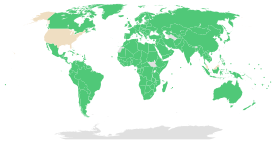Persistent organic pollutant
Persistent organic pollutants (POPs) are organic compounds that are resistant to environmental degradation through chemical, biological, and photolytic processes.[1] For this reason, they persist in the environment for a long time. They can be transported over long distances and bioaccumulate in human and animal tissue. When going up a food chain, there will be larger amounts of these substances.[1] For this reason, they have a large impact on human health and the environment.

Many POPs are currently or were in the past used as pesticides. Others are used in industrial processes and in the production goods such as solvents, polyvinyl chloride, and pharmaceuticals.[1] There are a few natural sources of POPs; most POPs are created by humans in industrial processes, either intentionally or as byproducts.[1]
References
change- ↑ 1.0 1.1 1.2 1.3 Ritter L. "Persistent organic pollutants" (PDF). Solomon KR, Forget J, Stemeroff M, O'Leary C. United Nations Environment Programme. Archived from the original (PDF) on 2007-09-26. Retrieved 2007-09-16.